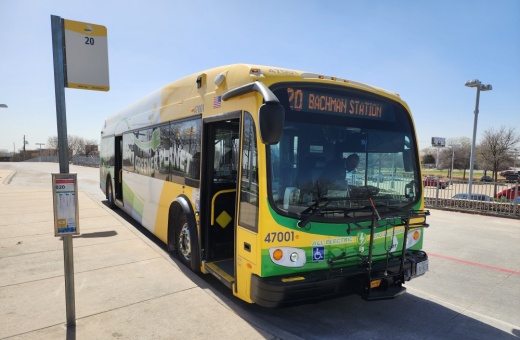The $780,000 bus began service in March and operates on DART’s Bus Route 20, which runs mostly along Northwest Highway from Bachman Station to the South Garland Transit Center. The route includes a stop at the intersection of Skillman Street at Merriman Parkway and another at White Rock Station.
DART spokesperson Gordon Shattles said the long-range electric bus joins DART’s fleet of seven short-range electric buses, which were launched in 2018. The short-range buses have a range of about 30 miles, while the new long-range bus has a range of about 300 miles. Shattles said now that the bus has operated for a few weeks, the agency has seen that the bus can sometimes surpass its minimum 300-mile range.
DART’s fleet of electric buses is a sign of the agency’s commitment to evolving and finding more efficient and environmentally sustainable transit options, Shattles said. When DART first launched, its buses ran on diesel because that was the “fuel of choice” at the time. Since then, DART has tried using liquid natural gas for a short period, low sulfur-diesel and compressed natural gas, which it uses now.
“This [electric bus] is a great test vehicle to determine what is the future of fuel for DART,” he said.
When riding the electric bus, riders will have a similar experience to riding DART’s nonelectric buses. However, the new bus has all-vinyl seats, which will make cleaning them much easier, Shattles said. Each seat is also equipped with a USB port for riders to charge their mobile devices.
“For our riders, the difference will be negligible,” Shattles said. “It’ll of course be much quieter.”
Throughout the next year, DART will be monitoring how the long-range electric bus responds to Texas’ wide range of temperatures and weather conditions. Shattles said the bus will need to efficiently maintain heat in the winter and keep its interior cool when temperatures are in the triple digits during the summer. Right now, it’s unclear how well the bus will adapt to extreme weather, Shattles said.
Another concern for the agency is the extreme winter storms Texas has experienced during its last few winters, Shattles said. For example, the severe winter storm in February 2021 that shut down the state’s electric grid could raise issues for the use of electric vehicles.
“No matter what the weather brings, we have to provide service,” Shattles said.
The new bus’s performance and long-term viability will help determine whether the agency will choose to expand its supply of long-range electric buses in the future.





